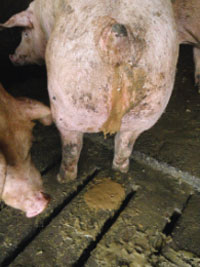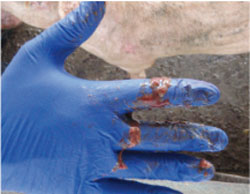



New study demonstrates dysentery-combating abilities of zinc chelate in swine diets
A new study published in Porcine Health Management evaluates the ability of zinc chelate to improve general clinical signs associated with swine dysentery while improving average daily weight gain.Brachyspira hyodysenteriae is the primary cause of swine dysentery, characterised by bloody to mucoid diarrhoea due to mucohaemorrhagic colitis in pigs. It primarily affects pigs during the grow/finishing stage and if it takes hold in your herd it can be one of the most expensive and possibly impossible diseases to eradicate, especially in growing pigs.
According to a recent paper published in Porcine Health Management, a worldwide re-emergence of the disease has recently been reported with an increasing number of isolates demonstrating decreased susceptibility to several crucially important antimicrobials in the control of swine dysentery.

What are the clinical signs of swine dysentery?
The typical pig affected by B. hyodysenteriae will initially have a raised temperature of 41°C (normal range 38.7-39.8°C) for a few days, and will appear dull, depressed, with little or no appetite and sunken sides to its abdomen. The faeces produced will range from soft to almost water in consistency with possible staining of the skin under the anus, with a distinctive, unpleasant smell. It will contain blood, mucus and in severe cases bits of the gut wall lining. Blood will start to appear in increasing amounts eventually turning the faeces from light brown and sloppy to black with a tar like consistency. The pig's appetite noticeably decreases as the disease progresses; it rapidly loses condition as it becomes dehydrated and takes on a gaunt appearance with sunken eyes. Dehydration is common and while mortality is usually low, death may occur as a result of salt poisoning (rising salt levels in the brain) due to dehydration. Death is a more common occurrence in heavy finishers than other age groups. Pigs sometimes show evidence of pain with rapid tail twitching.

Treatment
Various antibiotics available on veterinary prescription only (POMv) have been shown to have positive activity against B. hyodysenteriae, including Lincomycin, Tiamulin, and Tylosin. Zinc oxide is also commonly used to prevent and treat scours (diarrhoea) in young pigs, particularly in the post-weaning phase. Both of these treatments are now strictly regulated by authorities for a number of reasons:
- Routine use and overuse of antimicrobials in farming, sometimes blanket application of an entire herd, is believed to be one of the primary causes of resistance to some of the most critical antibiotics, antifungals and antiparasitics. Reducing the use of all antibiotics and replacing this with higher welfare, more sustainable solutions is one method for ensuring that antibiotics required in farming remain efficacious for the foreseeable future.
- The use of ZnO in European pig production has strongly increased since the EU banned the use of antibiotic growth promoters such as colistin in 2006 to curb the development of antimicrobial resistance (EW Nutrition, 2019). With zinc being a heavy metal, too much of it is toxic for the animal, hence excessive zinc intake is excreted by the animal. The bioavailability and absorption of zinc from zinc oxide is particularly low so most of the zinc given to piglets in this way accumulates in their manure and from there contaminates soils and groundwater - a concern for the health and growth of the affected ecosystem.
The current study
A novel non-antibiotic zinc chelate has been reported to demonstrate positive effects on faecal quality and consistency, general clinical signs, average daily weight gain and B. hyodysenteriae excretion during and after a 6-day oral treatment for swine dysentery. The current study aimed to evaluate the zinc chelate (Intra Dysovinol® 499 mg/ml (ID); Elanco) on naturally occurring swine dysentery due to B. hyodysenteriae under field conditions in the Netherlands.
Methodology
Husbandry
- Two farms with clinical disease due to B. hyodysenteriae in grow/finisher pigs within two weeks preceding the start of the study or preventing clinical signs due to B. hyodysenteriae by strategic application of antimicrobial drugs (but showing relapse upon cessation of therapy) were included in this study.
- Pigs were not allowed to receive any preventive or curative antimicrobial drug for B. hyodysenteriae in the 10 days preceding Study Day (SD) 0 (first day of administration of ID).
- Animals were fed dry feed and no increased levels of zinc or copper via the feed or drinking water were allowed.
- Pens included in the study had identical stocking density per pen, feed, climate and management.
Determining the study group
- A pen was included when at least 10 percent of the animals in the pen were qPCR-positive for B. hyodysenteriae at SD − 3 and at least one of the pigs was showing a non-normal faecal score. Only post-weaned pigs, showing non-normal faecal scoring and excreting B. hyodysenteriae at SD − 3 and/or at SD0 or SD2 (the latest) were included in the study for individual follow-up within selected pens.
Treatment
- Intra Dysovinol® 499 mg/ml (Elanco) consists of 499 mg of Zn-Na2-EDTA per ml as an active ingredient in an aqueous solution further containing colourants and a preservative. Upon inclusion, the pen was randomly assigned to control or treatment with ID at a dosage of 0.023 ml product per kg bodyweight for the duration of 6 days (according to SPC specifications), starting at SD0 and ending at SD6. Based on the total bodyweight and total water consumption of all animals in a single pen, a 100 times concentrated pre-dilution was dosed at 1 percent to the drinking water using a calibrated dosing pump.
Observations and sampling
- All animal observations and collection of animal samples were carried out by the observer. At pen level, general health observations on all pigs in the selected pens were recorded from SD − 3 until to SD14.
- Individual clinical observations were conducted at SD 0, 1, 2, 3, 4, 5, 6, 10 and 14 and scoring for general clinical condition, alertness, lameness and signs of respiratory diseases.
- For evaluation of the faecal quality, scoring was performed at SD 0, 2, 4, 6 and 14 according to a standardised scoring grid. Faecal scoring included consistency, colour and additions (mucus, foam, blood and necrotic material) and was added to obtain the total faecal score (TFS).
- Rectal faecal samples were collected at SD -3, 0, 2, 4, 6 and 14 in 50 ml sterile vials (MLS nv, Menen, Belgium). At SD − 3, the samples were analysed for the presence of B. hyodysenteriae by Real-Time PCR based on the nox gene.
Conclusions
- Intra Dysovinol® 499 mg/ml – containing a Zn-Na2-EDTA complex – significantly reduced B. hyodysenteriae shedding in faeces within its 6-day treatment.
- Treatment with ID improved general clinical signs at SD6 and total faecal score (TFS) at SD14 in naturally B. hyodysenteriae infected pigs.
- The positive effects of ID treatment remain for at least eight days after cessation of oral ID therapy.
- Pigs remaining in a highly contaminated environment may be re-infected following the end of ID treatment, however, this is not different to standard antimicrobial therapy.
- The ID treatment resulted in a higher growth rate and improved general health, whereas no mortality was observed and no additional therapeutic treatments were necessary in contrast to the control pigs.
- Control of swine dysentery should combine an efficacious treatment with additional management practices to reduce the environmental infection pressure in order to limit re-infection as much as possible.
General biosecurity rules for preventing swine dysentery
If your herd is not infected with SD then strict biosecurity measures with all incoming stock – including all show returns, plus disinfection of all incoming vehicles including your own vehicles, the fellman and feed trucks, and take a serious approach to vermin control. If there has been a case of SD at or taken home from a show then seriously consider extending the isolation period to 60 days before returning the pigs to the main herd. The stricter you are at times of risk the more successful you will be, even in heavily populated pig areas.
If you already have SD on your farm then preventing the movement of the organism between groups of pigs in your herd is your best control. Management procedures should include where possible an all-in all-out system, with rigorous cleansing and disinfection between each batch. SD is sensitive to most disinfectants and in particular the phenol based ones eg, Virkon LSP™. It really goes without saying but if you already know your herd has SD then please do not hire in boars, exhibit your pigs, visit another breeder’s pig herd or sell your weaners on until the situation is controlled.
| References | ||||
|---|---|---|---|---|
| Frédéric Vangroenweghe, Liesbeth Allais, Ellen Van Driessche, Robbert van Berkel, Gerwen Lammers & Olivier Thas | ||||
| (2020) | Evaluation of a zinc chelate on clinical swine dysentery under field conditions.. Porcine Health Management | 6:1 |









